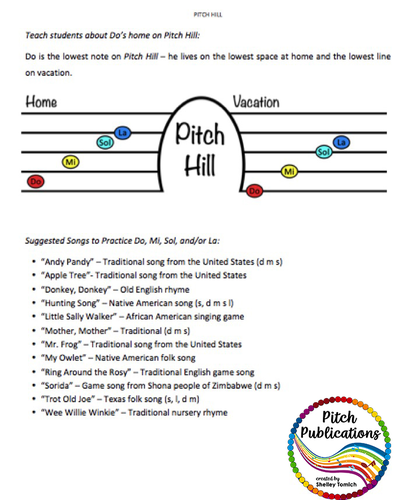





Are you struggling with teaching solfége or looking for a fun, new method for teaching solfége to elementary students? Then look no further! Pitch Hill is for you!
In Pitch Hill, each solfège note is a character with his or her own story. For example, Do is a Boxer! He LOVES to box! He wears special head gear and boxing gloves to protect him and when we sing the note that is Do, we show our hands like boxing gloves. Do is very strong and will catch Re if she falls off the roof! (You will have to purchase to hear her story!)
The stories provide a way to remember the corresponding hand sign as well as help explain the relationship between individual pitches. Though the system is enhanced by technologies available in many schools (iPads, IWB, etc.) it can also be taught using a simple chalkboard. Pitch Hill was created to overcome the challenge of teaching solfege notes by engaging visual, auditory, and kinesthetic learning modalities as well as captivating students with wonderful story telling.
Pitch Hill is appropriate for teaching things such as scales, pentatic scales, melody, pitch, singing, and harmony. It is appropriate for people following kodaly, orff, or any other method of music education! (It makes a great alternative to those who are familiar with the music street stories for teaching solfege (solfeggio, solfa, etc).
…
In this listing you will receive:
- An overview of how to teach Pitch Hill
- A catchy song for each character!
- A brief history of solfege and how to introduce this history to students.
- 19 lesson plans using Pitch Hill, including standards covered, process, and interdisciplinary connections.
- A list of folk and multi-cultural songs that use each progression of pitch patterns.
- 8 lessons from Pitch Hill incorporate children’s literature with music into the lesson.
- 18 funsheets (worksheets) that can be used to assess students progress in identifying solfege characters.
- Rubrics to assess students on their singing and instrument performances that go along with Pitch Hill
…
Note: Pitch Hill does NOT teach sharps, flats, or naturals. It is intended to be a resource to introduce students to singing solfege and using the Curwen hand signs. The characters are not animated; I show the actual levels of the hand signs through teacher-led instruction.
…
Like this product? You will also love:
- Music Center: Don’t Break the Pitches! - Bass Clef Pitch Note Reading Game
- Back to School Music Lesson Plan! 4th and 5th Turn the Beat Around Cup Game
…
Shelley Tomich
www.pitchpublications.com
Visit my website to join the Free Resource Library!
Teach music. Love life.
Something went wrong, please try again later.
Thank you for sharing your resource. This resource has been recommended for teachers by the TES Resource Team.
Report this resourceto let us know if it violates our terms and conditions.
Our customer service team will review your report and will be in touch.